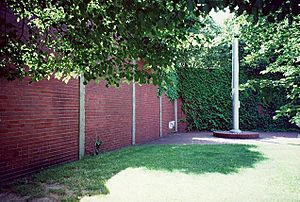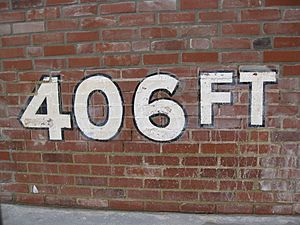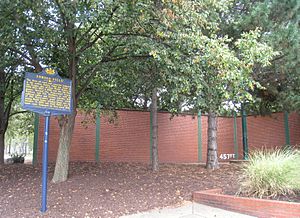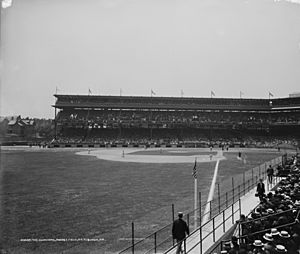Forbes Field facts for kids
|
"The House of Thrills"
"The Old Lady of Schenley Park" "The Oakland Orchard" |
|
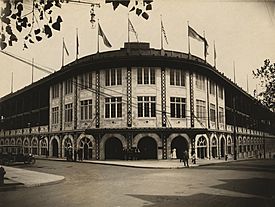 |
|
| Location | 230 South Bouquet St. in Oakland, adjacent to Schenley Park |
|---|---|
| Capacity | 23,000 (1909) 41,000 (1925) 35,000 (1970) |
| Field size | 1954–1970: Left field—365 feet (111 m) Left center—406 feet (124 m) Center field—457 feet (139 m) Right center—408 feet (124 m) Right field—375 feet (114 m)  |
| Surface | Grass |
| Scoreboard | Hand-operated |
| Construction | |
| Broke ground | March 1, 1909 |
| Built | March–June 1909 |
| Opened | June 30, 1909 |
| Closed | June 28, 1970 |
| Demolished | 1971 |
| Construction cost | Estimated US$1–2 million ($32.6 million – $65.1 million in 2022 dollars ) |
| Architect | Charles Leavitt Jr. |
| General contractor | Nicola Building Company |
| Tenants | |
| Pittsburgh Pirates (MLB) (1909–1970) Pittsburgh Steelers (NFL) (1933–1963) Philadelphia–Pittsburgh "Steagles" (NFL) (1943) "Card-Pitt" (NFL) (1944) Pittsburgh Panthers (NCAA) (1909–1924) Carnegie Tech Tartans (NCAA) (1922-1928) Duquesne Dukes (NCAA) (1933–1942, 1947–1950) Homestead Grays (Negro leagues) (1922–1939) Pittsburgh Americans (AFL) (1936–1937) Pittsburgh Phantoms (NPSL) (1967) |
|
|
Pennsylvania Historical Marker
|
|
| Designated: | July 7, 2006 |
| Official name: Forbes Field wall: remnant | |
| Designated: | 1977 |
Forbes Field was a famous baseball park in Pittsburgh, Pennsylvania. It was home to the Pittsburgh Pirates baseball team for over 60 years, from 1909 to 1970. The stadium also hosted the Pittsburgh Steelers football team and the University of Pittsburgh's "Pitt" Panthers football team.
Forbes Field was built to be very strong, using concrete and steel instead of wood. This made it one of the first modern stadiums. It had a huge playing field, which made hitting home runs a real challenge! Over the years, many exciting games were played there, and the Pirates even won three World Series championships. Today, parts of the old stadium still stand, reminding everyone of its amazing history.
Contents
History of Forbes Field
Building a New Ballpark
In 1903, Barney Dreyfuss, who owned the Pittsburgh Pirates, wanted a bigger and better stadium. He bought a large piece of land near Schenley Park in Pittsburgh. Some people thought the location was too far from downtown, calling it "Dreyfuss's Folly." But the area grew, and soon it was a great spot.
Dreyfuss spent about $1 million to build Forbes Field. He wanted a stadium that would last a long time. So, he decided to build it with strong steel and concrete. This was a new idea for baseball stadiums back then.
The stadium was designed by Charles Wellford Leavitt Jr., an engineer. Construction started on March 1, 1909, and was finished in just 122 days! The stadium was named after General John Forbes, who helped name the city of Pittsburgh in 1758.
First Game at Forbes Field
The very first game at Forbes Field was on June 30, 1909. The Pittsburgh Pirates played against the Chicago Cubs. Fans were so excited that they started arriving six hours early! The weather was sunny and warm.
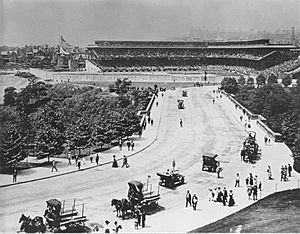
Pittsburgh's mayor, William A. Magee, threw out the first pitch. A huge crowd of over 30,000 people watched the game. The Pittsburgh Press newspaper said it was the biggest crowd ever for such an event. Even though the Cubs won the first game 3–2, everyone was thrilled with the new stadium.
Changes to the Playing Field
Forbes Field was known for its very large playing field. The owner, Barney Dreyfuss, didn't want easy home runs. The outfield fences were far away, making it tough for batters to hit balls out of the park. This meant that triples (when a batter reaches third base) and inside-the-park home runs were more common.
Over the years, the field changed a bit. In 1925, more seats were added, which made the right field line shorter. This made it a little easier to hit home runs in that area. In 1935, Babe Ruth hit the last three home runs of his career at Forbes Field. One of them was so powerful it cleared the right field roof!
Later, in 1947, the bullpen (where relief pitchers warm up) was moved. This made the left field area shorter, and fans called it "Greenberg Gardens" and then "Kiner's Korner" after famous sluggers. But the field was returned to its original large size in 1954.
Even with its long history, Forbes Field never had a no-hitter (when a pitcher doesn't allow any hits) in over 4,700 games!
Seating and Tickets
When Forbes Field first opened, it could hold 25,000 fans, which was the biggest in the league. Over time, more seats were added, and by 1925, it could hold 41,000 people.
Tickets for the first game cost between $0.50 and $1.25. Sometimes, if a game was very popular, fans were allowed to sit on the grass in the outfield! The biggest crowd ever at Forbes Field was 44,932 people in 1956.
Closing and Demolition
After 60 years, Forbes Field started to get old. It was the second oldest baseball park in the league. Also, the area around the stadium had become very busy, making parking difficult.
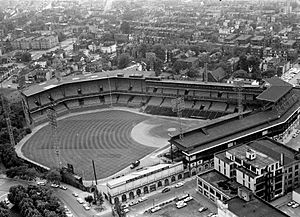
The University of Pittsburgh bought Forbes Field in 1958. The Pirates continued to play there until a new stadium, Three Rivers Stadium, was built. The last game at Forbes Field was on June 28, 1970, between the Pirates and the Chicago Cubs. The Pirates won 4–1.
After the game, the home plate was dug up and flown by helicopter to the new Three Rivers Stadium. Sadly, Forbes Field was torn down in 1971 to make way for new university buildings.
Remembering Forbes Field
Even though the stadium is gone, many things remind people of Forbes Field. A statue of baseball legend Honus Wagner was moved from Forbes Field to PNC Park, the Pirates' current home.
A piece of the left field wall, where Bill Mazeroski hit his famous World Series-winning home run, was saved. It is now on display outside PNC Park. The original spot of that wall is marked with bricks and a plaque near the University of Pittsburgh.
The actual home plate from the last game is preserved inside the University of Pittsburgh's Posvar Hall. Also, every October 13, fans gather at the old outfield wall to listen to a radio broadcast of Mazeroski's famous home run game. It's a special tradition that brings fans together.
Exciting Events at Forbes Field
Baseball Highlights
| Years | Capacity |
|---|---|
| 1909–1914 |
|
| 1915–1924 |
|
| 1925–1937 |
|
| 1938 |
|
| 1939–1941 |
|
| 1942–1946 |
|
| 1947–1952 |
|
| 1953–1959 |
|
| 1960–1970 |
|
In its first year, 1909, Forbes Field saw the Pirates win the 1909 World Series. It was a big moment for the team and the city.
Forbes Field was also the site of the first live radio broadcast of a Major League Baseball game in the United States. This happened on August 5, 1921, when Harold Arlin described the game between the Pirates and the Philadelphia Phillies over KDKA radio.
In 1925, the Pirates made history again by winning the 1925 World Series. They came back from being down three games to one, which was a huge achievement. Their third and final World Series win at Forbes Field was in 1960, thanks to Bill Mazeroski's famous home run.
On May 25, 1935, baseball legend Babe Ruth hit his last three career home runs at Forbes Field. One of them was a massive shot that cleared the right field roof!
The Homestead Grays, a famous Negro League team, played all their home games at Forbes Field from 1922 to 1939. Stars like Josh Gibson played there. In 1930, the Grays played the first night baseball game in Pittsburgh at Forbes Field.
Football Games
The University of Pittsburgh's football team, the Panthers, played at Forbes Field from 1909 to 1924. They had many successful seasons, including five undefeated seasons where they were named national champions.
Forbes Field also hosted the first live radio broadcast of a college football game in the United States, on October 8, 1921, between Pitt and West Virginia.
Art Rooney founded the Pittsburgh Steelers (originally called the Pittsburgh Pirates) in 1933. Their first game was at Forbes Field on September 20, 1933. The Steelers played at Forbes Field until 1963, before moving to Pitt Stadium.
Other Events
Forbes Field wasn't just for baseball and football. It also hosted many exciting boxing matches. Famous boxers like Harry Greb and Billy Conn fought there. In 1951, the heavyweight boxing championship was held at the stadium.
The stadium also hosted other unique events, like a large communion service in 1909 and a mine safety demonstration in 1911, which was even attended by President William H. Taft. Forbes Field truly was a place for many different kinds of gatherings and entertainment.



